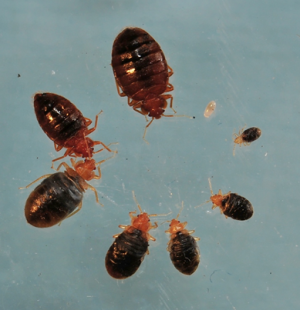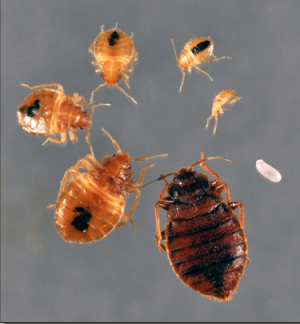Introduction To The Common Bed Bug Biology And Management
|
|
Pomerix staff
Published: 2021-10-11
|
Bed bugs are insects that feed on humans and other animals. The common bed bug (Cimex lectularius) prefers to feed on human blood but may occasionally feed on cats, dogs, and other pests. Like other insects, nymphs and adults have six legs and a pair of antennae.
Where did bed bugs come from
Bed bugs most likely originated in caves where the ancestor of common bed bugs fed on bats. Then, at some point, they switched to humans. When humans left the caves to live in man-made structures, they followed him. Unfortunately, they still follow humans by hitchhiking from one place to another, which is how they spread.
Bed bug resurgence
Bed bugs were not a significant problem in the 1960s to early 1990s. However, in the late 1990s, they made a comeback and became increasingly more common. Scientists are not sure why and how exactly this happened, but various hypotheses link the bed bug resurgence to increased travel to and from areas of the world where bed bugs remained common, increased exchange of second-hand furniture, a shift from premise-wide use of broad-spectrum insecticides to more selective control tactics for other urban pests, and insecticide resistance (Alvaro Romero, Michael F. Potter, Daniel A. Potter, And Kenneth F. Haynes 2007 – Journal of Medical Entomology).
Bed bug morphology and identification
Bed bugs have a flat body with a round contour, six legs (3 pairs), and two antennae. The adults are mahogany to rusty-brown, but nymphs are translucent. Their size range is from a sesame seed to an apple seed. An unfed nymph is hard to see simply because of its translucent color. When a nymph takes a blood meal, however, they become bright reddish and later reddish-brown. Bed bugs have five immature stages called instars. A nymphal instar can grow to the next stage only by molting. The final molt converts a nymph into an adult bed bug.
Similar-looking species
Bed bugs can be mistaken for many other species. Commonly, bed bugs are mistaken with mites, cockroach nymphs (immature stage), ticks, stink bugs, etc. The “common bed bug” that feeds on humans differs from the “bat bug” that primarily feeds on bats. They look very similar to each other except for some subtle morphological features.
Bed bug life cycle
A bed bug’s life starts with an egg, followed by five nymphal stages, and finally, the adult stage. Female bed bugs lay up to 200 eggs in their lifetime at a rate of 1-5 eggs daily. It may take between five weeks to four months for the eggs to develop into adults depending on the temperature and availability of their host. Bed bugs must feed on blood before molting into the next stage. All of the life stages, including egg and 1st instars, are visible to the naked eye. However, the eggs and unfed 1st and 2nd nymphal instars are hard to see on white or off-white surfaces since they are white and translucent.
Bed bug size at each life stage:
- Egg: ~1mm
- 1st instar: ~1.5 mm
- 2nd instar: ~2 mm
- 3rd instar: ~2.5 mm
- 4th instar: ~3 mm
- 5th instar: ~4.5 mm
- Adult: ~5-7 mm
Bed bug dispersal
Bed bugs do not have functional wings and do not fly. However, adults possess wing buds on their thorax. They cannot jump either. The only way for a bed bug to move from one surface to another is by crawling. This behavior is critical in bed bug control since we can control a bed bug population by blocking their access to the bed and other furniture. Bed bugs are excellent hitchhikers and can hitchhike on coats, the bottom of shoes, bags, furniture, wheelchairs, etc.
Bed bug monitoring
To monitor bed bug activity and to partially control bed bugs, one can place bed bug interceptors in various places in the house. Bed bug interceptors are moat-like traps that can be placed under furniture legs or as a standalone setup in the corner of a room or under a bed. The moat structure in these interceptors has slick surfaces, which prevents bed bugs from crawling out. After a few days, trapped bed bugs can be counted and removed.
Bed bug bite symptoms
Bed bugs bite humans and occasionally pets too. The symptoms of the bite may vary significantly from person to person. Some people develop a rash or a raised or flat red spot, typically 1/16 to 25/32 inch (2-20 mm) wide. They may appear in a row or a cluster and occur primarily on exposed upper body areas (face, neck, shoulders, arms, and hands). The bites may also cause several systemic reactions such as asthma, edema, iron deficiency anemia, and in very rare cases, anaphylactic shocks. Therefore, you must avoid scratching the bites to prevent infections. For more information on bite identification, please read this article
Bed bug management
There are many ways by which you can get rid of bed bugs, but each has its advantage and disadvantage. To control bed bugs, you can use one or more of the following methods:
- Vacuuming
- Trapping using bed bugs interceptors
- Using mattress covers to prevent them from entering or exiting the mattress
- Freezing
- Heat treatments:
- Whole room/house
- Dryer
- High-power steamer
- Pesticides
- Pressurized aerosol can
- Liquid insecticide
- Dust insecticide
- Whole-house fumigation (a.k.a tenting)


